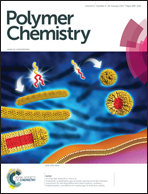Novel multiarm star block copolymer ionomers as proton conductive membranes
Abstract
A series of well-defined novel multiarm star block copolymer ionomers with an average of 6, 11 and 15 arms, sulfonated polystyrene-block-poly(2,2,3,3,3-pentafluoropropyl methacrylate) (SPS-b-PFPMA), were prepared via a combination of atom transfer radical polymerization (ATRP), Diels–Alder click reaction and postsulfonation reaction. First, multiarm star polymer with anthracene functionality as reactive periphery groups was prepared by a cross-linking reaction of divinyl benzene using α-anthracene end functionalized PS (PS-anthracene) as a macroinitiator. Thus, obtained multiarm star polymer was reacted with furan protected maleimide-end functionalized PFPMA (PFPMA-MI) resulting in the corresponding fluorinated multiarm star block copolymers via Diels–Alder click reaction. The third step involves the sulfonation reaction of phenyl ring of polystyrene block with acetyl sulfate at 20 °C. The structures, molecular characterization and thermal properties of the multiarm star block copolymers were characterized by 1H nuclear magnetic resonance (1H NMR) and infrared (IR) spectroscopy, size exclusion chromatography (SEC), differential scanning calorimetry (DSC) and thermogravimetric analysis (TGA). Thermal analysis indicated separate glass transitions of the PFPMA and PS phases. Both the membranes from sulfonated multiarm star block copolymer and its sulfonated poly(phenylene oxide) (SPPO) blends were prepared by solution casting method. All of the multiarm star block ionomers were readily soluble in N,N-dimethyl acetamide. The influence of star functionality and ion exchange capacity (IEC) of star ionomers on the flexibility and the proton conductivity of ionomer membranes were examined. 6-arm star block copolymer ionomer membrane with 1.00 mmol g−1 IEC exhibited conductivity (19.37 mS cm−1) higher than that of SPPO with 1.34 mmol g−1 IEC (3.82 mS cm−1) measured at 80 °C and relative humidity of 100%. The morphology of dry membranes was investigated by scanning electron microscopy (SEM). This work showed that it is possible to tailor and prepare proton exchange membrane with well-defined architecture by employing star block copolymers with a sulfonated core bearing hydrophobic fluorinated periphery.


 Please wait while we load your content...
Please wait while we load your content...